Comments / Questions (71)
![]() Chantal Gloutnay wrote:
Chantal Gloutnay wrote:
Je fais la taille Small. J’ai mis les 83 mailles du dos en attente. Je dois faire le ventre. Je reprend les 15 mailles et reprend le jacquard à partir de la ligne an haut de la flèche et étoile? Il y a seulement 10 mailles dans cette répétition et le ventre en a 15?
06.02.2025 - 21:18DROPS Design answered:
Bonjour Mme Gloutnay, lorsque vous reprenez les mailles du ventre, continuez à tricoter le diagramme à partir du dernier rang que vous aviez tricoté avant la division; tout va donc dépendre de votre tension en hauteur et du dernier rang tricoté avant la séparation. Continuez juste le diagramme pour que le motif ne soit pas décalé (comme pour le dos, notez la 1ère maille sur l'endroit et sur l'envers pour savoir comment lire les diagrammes sur l'envers). Bon tricot!
07.02.2025 - 08:31
![]() Chantal Gloutnay wrote:
Chantal Gloutnay wrote:
Je Tricotteuses la grandeur Small. Après avoir mis les 15 mailles sur un arrêt de mailles, et avoir continué le jacquard sur les 79 mailles restantes, comment je fais les allers retours avec des broches circulaires? Ma laine traverse toujours les 15 mailles sur arrêt de maille?
05.02.2025 - 15:48DROPS Design answered:
Bonjour Mme Gloutnay, lorsque vous avez mis les 15 mailles en attente, continuez maintenant à tricoter les mailles du dos en allers et retours, autrement dit, vous allez maintenant les tricoter alternativement sur l'endroit et sur l'envers. Notez bien dans le diagramme la 1ère et la dernière maille du jacquard sur l'endroit et tricotez maintenant le jacquard sur les mailles restantes du dos en lisant le diagramme de gauche à droite. Bon tricot!
05.02.2025 - 16:16
![]() Lyne wrote:
Lyne wrote:
Je fais le modèle de pull pour chien valentino grandeur small. Je suis au stade ou j’ai 79 mailles sur ma broche et le patron me dit d’ajuster a 83 mailles. Je ne comprends pas ce qu’il faut faire, ajouter 4 mailles au debut du rang?
03.02.2025 - 21:47DROPS Design answered:
Bonjour Lyne, vous devez augmenter ces 4 mailles à intervalles réguliers sur le rang indiqué - cette leçon vous aidera à savoir comment placer vos augmentations. Bon tricot!
04.02.2025 - 09:07
![]() Lia Koot wrote:
Lia Koot wrote:
Waar exact mt opmeten voor hond
22.12.2024 - 18:19DROPS Design answered:
Dag Lia,
Excuses voor het late antwoord. De borstwijdte is het wijdste gedeelte rondom de borst vlak achter de voorpoten. De achterpand lengte zoals aangegeven is ongeveer van de nek tot de staart.
21.01.2025 - 20:39
![]() Anna wrote:
Anna wrote:
En ymmärrä, mihin/ miten tehdään toisen jalan aukko?
24.11.2024 - 19:48
![]() Carole wrote:
Carole wrote:
Mes chiens ont un tour de poitrail de 35cm & 37 cm. Quel grandeur je devrais prendre ?
07.11.2024 - 17:32DROPS Design answered:
Bonjour Carole, vous devez choisir soit un taille S mais il sera alors très ajusté, soit un taille M mais ce sera peut être un peu trop large. Bon tricot!
08.11.2024 - 07:34
![]() Dewerdt wrote:
Dewerdt wrote:
Comme je ne sais pas tricoter avec des aiguilles circulaires. J’aimerais avoir le modèle avec des aiguilles normal. Merci
23.07.2024 - 16:19DROPS Design answered:
Bonjour Mme Dewerdt, ce modèle est uniquement disponible à tricoter en rond; cette leçon devrait pouvoir vous aider à adapter les explications sur aiguilles droites. Bon tricot!
29.07.2024 - 11:15
![]() Janet Terpstra wrote:
Janet Terpstra wrote:
Waarom moet ik halverwege het patroon (maat s) nog 4 st extra opzetten. Zo komt het patroon niet meer uit. Het patroon moet deelbaar zijn door 16 lijkt mij. Kunnen jullie hiermee helpen? Groet Janet
08.04.2024 - 21:30DROPS Design answered:
Dag Janet,
Als ik het goed heb, heb je daarna 100 steken op de naald staan en het telpatroon is volgens mij op dat punt ook 10 steken breed.
09.04.2024 - 21:03
![]() Denna Neff wrote:
Denna Neff wrote:
Where does Leg Opening start? My confusion is derived from the mention in parentheses that leg opening will measure 3" for Small.) Stitches are evenly adjusted to 83. Once I work remainder of Chart with a 10 st repeat, +/- extra sts, the piece will measure 5-1/2". Then that is where these 83 sts will be placed on a new stitch holder? Then, slip belly back on another working needle, work same length as the back just placed on st holders?
25.02.2024 - 00:43DROPS Design answered:
Dear Mrs Neff, the leg opening starts when you cast off 1 st for leg opening and continue working back and forth the back piece for 3 inches, you then put these stitches aside, work front piece for 3 inches then put all stitches together for end of body. Happy knitting!
26.02.2024 - 08:55
![]() Denna Neff wrote:
Denna Neff wrote:
Working Small. Worked Chart to A.1-S to Arrow/Star where increased evenly to 83 sts. (15 sts remain on stitch holder.) Now beginning the Section of Chart at Arrow/Star which displays 10 sts (instead of 16 per section). Have not yet worked 5-1/2". Chart looks like a decrease every 10 out of 16 sts.. Is this part of the Chart actually separate from the first 40 rows? Or work 10 sts to reach the 5-1/2"? Where does the Leg Opening work start? Several of us are working pattern. No one knows.
25.02.2024 - 00:22DROPS Design answered:
Dear Mrs Neff, after you have worked the increase row and get 83 stitches just continue working diagram (back and forth over back piece for leg opening) as shown until piece measures 5-1/2 inches from the cast on row, ie you have worked back and forth for 3 inches for leg opening. Now slip stitches on a thread and work front piece for 3 inches, you will then work all stitches back together afterwards. Happy knitting!
26.02.2024 - 08:54
Valentino#valentinodogsweater |
||||||||||
 |
 |
|||||||||
Knitted DROPS dog's Christmas jumper for valentine with hearts in ”Karisma”. Size XS - L.
DROPS Extra 0-1010 |
||||||||||
|
PATTERN: See diagram A.1 (choose diagram for correct size). All rows in pattern are worked in stockinette st. ADJUSTMENT TIP: If you're knitting for another dog race than given here, note the distance between the dog's front legs (for example a Dachshund has a longer distance between the front legs than a Cocker Spaniel). The distance can be adjusted by slipping more or fewer sts on the stitch holder mid under belly. In addition the circumference on body can be adjusted by adding or subtracting sts (adjust so that sts fit the repetition) and the back can be worked longer or shorter. ---------------------------------------------------------- JUMPER: Worked in the round on double pointed needles/circular needle from the neck down. The smallest size is worked on double pointed needles, the other sizes on circular needle. Cast on 64-92-112-140 sts on double pointed needles/circular needle size 3 mm / US 2.5 with wine red. Work rib = K 2/P 2 for 6-8-10-12 cm / 2½"-3"-4"-4¾" (= neck). Switch to double pointed needles/circular needle size 3.5 mm / US 4 – NOW MEASURE PIECE FROM HERE! Work 2 rounds in stockinette st while AT THE SAME TIME dec 4-2-7-5 sts evenly on 1st round = 60-90-105-135 sts. READ ALL OF THE FOLLOWING SECTION BEFORE CONTINUING: Then work pattern according to diagram A.1 (choose diagram for correct size) = 4-6-7-9 repetitions on round. AT THE SAME TIME on 1st round marked with arrow in diagram (i.e. 1st round with medium pink) inc 4-6-7-9 sts evenly = 64-96-112-144 sts. When piece measures 4-6-9-12 cm / 1½"-2½"-3½"-4¾" (measured after neck), divide for front legs as follows: bind off 1 st, work the next 15-15-31-31 sts and then slip them on 1 stitch holder (= under the belly), bind off 1 st, then continue pattern back and forth on needle over the remaining 47-79-79-111 sts (= back piece). AT THE SAME TIME on round marked with arrow and star in diagram (= 1 round with wine red and applies to all sizes except Size XS), adjust no of sts to 47-83-77-107. When piece measures 10-14-18-22 cm / 4"-5½"-7"-8¾" (opening for legs measures approx. 6-8-9-10 cm / 2½"-3"-3½"-4" and the adjustment of no of sts should now be finished in the 3 largest sizes), slip sts on 1 new stitch holder. Slip sts from stitch holder under the belly back on needle (= 15-15-31-31 sts) and work pattern over these sts, the same length as on back piece. Slip all sts on the same needle again and cast on 1 new st in each side between over and under piece = 64-100-110-140 sts. Finish the pattern, then work with wine red until finished measurements. When piece measures 16-20-25-30 cm / 6¼"-8"-9¾"-11¾" work next round as follows: Work 2-0-8-6 sts, cast of the next 13-17-17-21 sts (= mid under belly) and work the rest of row. Then work back and forth on needle - AT THE SAME TIME bind off at the beg of every row in each side as follows: 2 sts 1-3-4-6 times, 1 st 9-8-9-8 times, 2 sts 1-3-4-6 times and 3 sts 1 time = 19-37-37-49 sts remain on needle. Piece measures approx. 30-38-47-56 cm / 11¾"-15"-18½"-22" incl the neck. ASSEMBLY: Slip the remaining sts on double pointed needles/circular needle size 3 mm / US 2.5, pick in addition up sts with wine red around the cast-off edge so that there are 84-112-144-188 sts in total. Work rib = K 2/P 2 for 2½-3-3-3½ cm / ¾"-1"-1"-1¼", then loosely bind off with K over K and P over P. LEG: Pick up 36-44-52-60 sts on double pointed needles size 3 mm / US 2.5 with wine red around one opening for leg. Work rib = K 2/P 2 until leg measures approx. 4-5-6-8 cm / 1½"-2"-2½"-3", then loosely bind off with K over K and P over P. Repeat around the other opening. NOTE: The neck is folded double when worn. |
||||||||||
Diagram explanations |
||||||||||
|
||||||||||
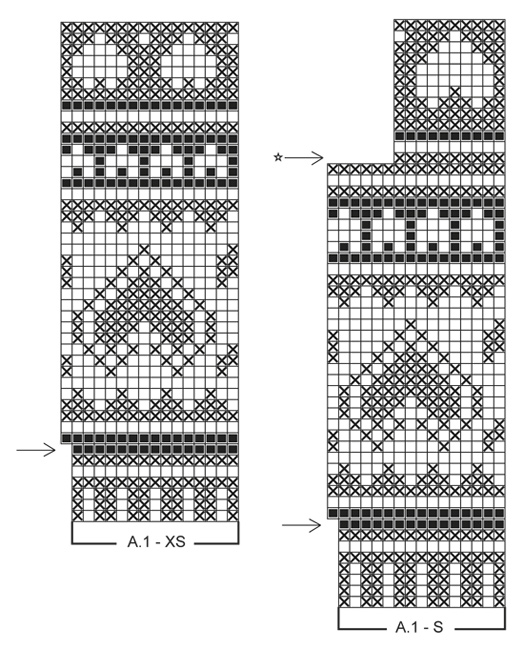
|
||||||||||
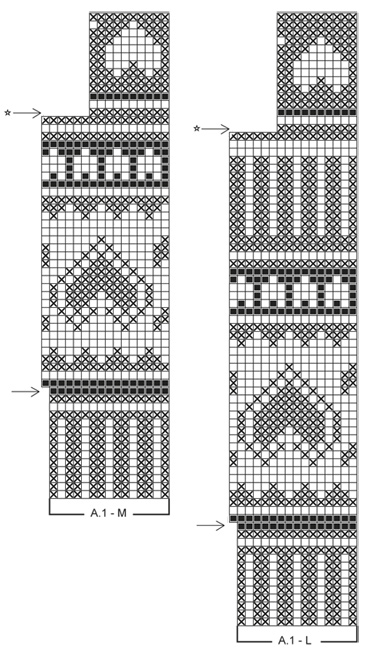
|
||||||||||
Have you finished this pattern?Tag your pictures with #dropspattern #valentinodogsweater or submit them to the #dropsfan gallery. Do you need help with this pattern?You'll find 21 tutorial videos, a Comments/Questions area and more by visiting the pattern on garnstudio.com. © 1982-2025 DROPS Design A/S. We reserve all rights. This document, including all its sub-sections, has copyrights. Read more about what you can do with our patterns at the bottom of each pattern on our site. |
||||||||||







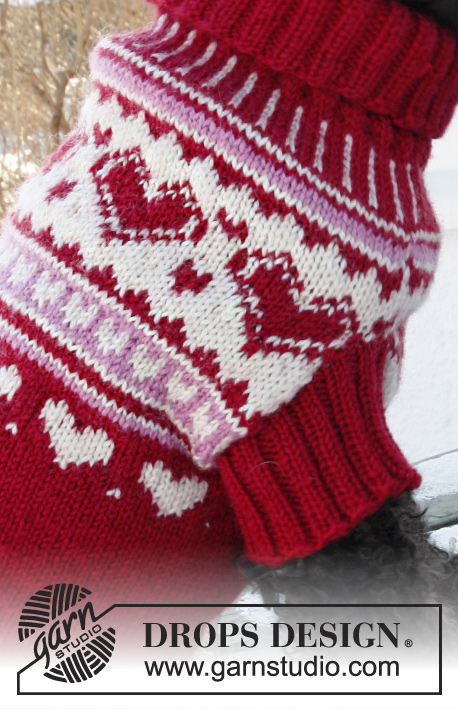
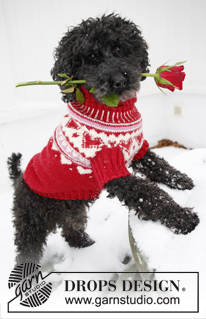
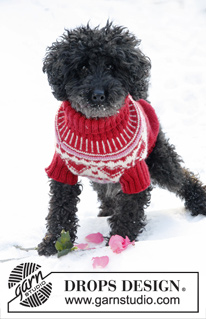
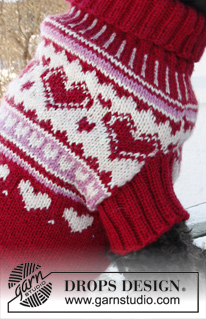




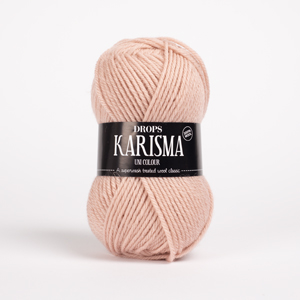

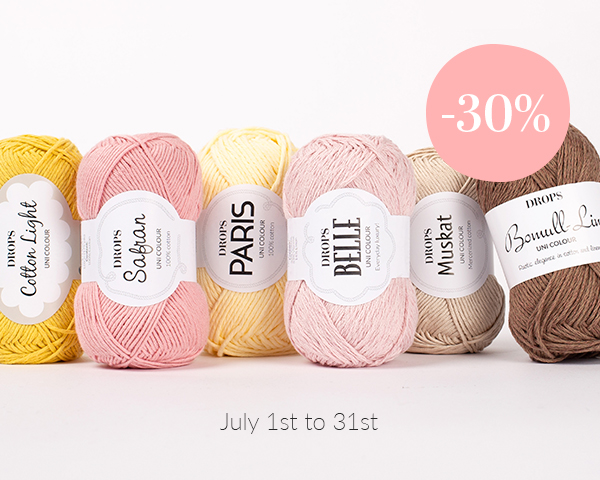
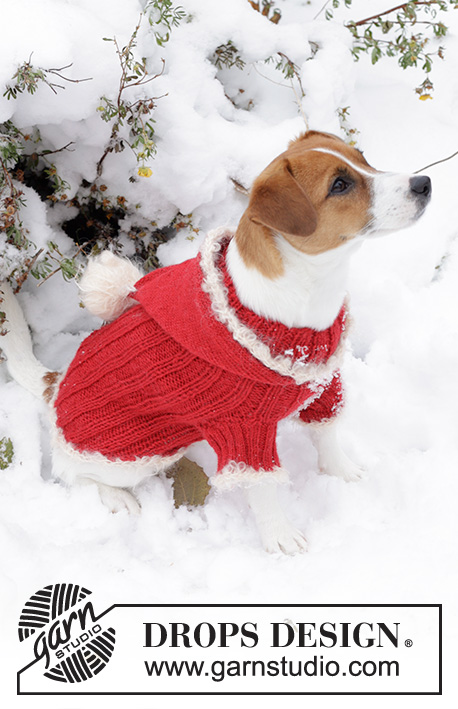
























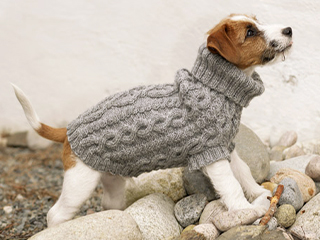












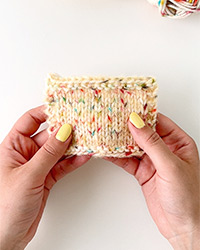
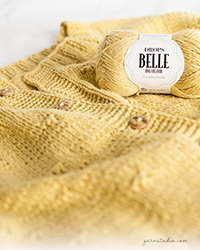
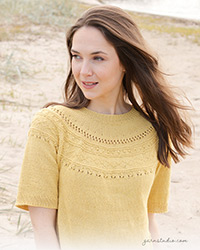
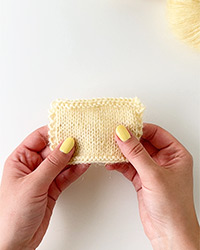

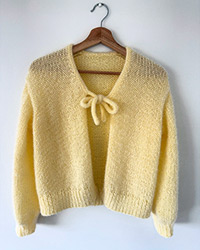
Post a comment to pattern DROPS Extra 0-1010
We would love to hear what you have to say about this pattern!
If you want to leave a question, please make sure you select the correct category in the form below, to speed up the answering process. Required fields are marked *.